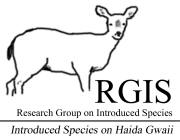|
Jean-Louis Martin, Stephen A. Stockton, Sylvain Allombert, Anthony
J. Gaston,
2010,
Top-down and bottom-up consequences of unchecked ungulate browsing
on plant and animal diversity in temperate forests: lessons from a
deer introduction, Biological
Invasions (2010) 12:353–371 - PDF
Abstract: Debate on the relative importance of competition for
resources and trophic interactions in shaping the biological
diversity of living communities remains unsettled after almost a
century. Recently, dramatic increases in ungulate populations have
provided a useful quasi-experiment on the effects of unrestrained
ungulates on forest ecology. The islands of Haida Gwaii (Canada)
offer a unique situation to investigate the potential of large
herbivores to control temperate forest community structure and
diversity. Black-tailed deer Odocoileus hemionus Merriam, native to
adjacent mainland areas of British Columbia, were
introduced in 1878 and spread to all but a few islands. Because deer
were not native to the archipelago, islands that still lack deer
provide a rare instance of temperate forest vegetation and fauna
that developed in the absence of large herbivores. The colonisation
of different islands at different times, and the absence of
significant predation allow us to assess whether and how a large
herbivore can exert ‘‘topdown’’ control on vegetation and its
associated fauna. We studied plant communities in forest interior
and shoreline, on seven small islands of varying browse history.
Three islands were untouched by deer, deer had been resident for
about 15 years on two, and on another two deer had been present for
more than 50 years. Without deer, vegetation in the understorey
and/or shrub layer was dense or very dense. Structure and
composition varied markedly within and between shoreline and
interior communities. Without deer, shoreline communities were
dominated by species absent from islands with deer. Where deer had
been present for less than 20 years most plant species
characteristic of shorelines on islands without deer were already
absent or scarce, but in the forest interior species richness was
less affected and extensive shrub thickets remained. On islands
where deer had been present for>50 years vegetation below the browse
line was extremely simplified, converging in both forest interior
and shoreline towards an open assemblage of a few deer-tolerant
species, basically two coniferous trees. This top down effect on the
plant community reflected up the food chain so that understorey
invertebrate and shrub dependent songbird communities became
simplified. In contrast, species densities of litter arthropods
(especially weevils and millipedes) were highest where deer were
present for>50 years. Canopy birds were unaffected by deer presence.
In the absence of predators, major climatic stress or other means to
control the herbivore, deer browsing created greatly simplified
plant and animal communities.
|

